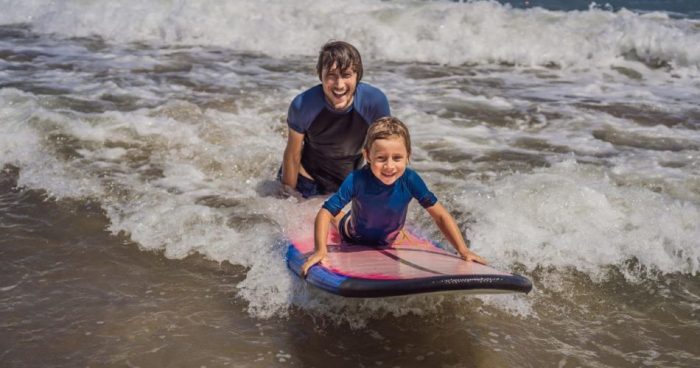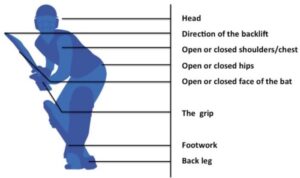Surfing basics kick off the ultimate wave-riding adventure, diving into the roots, gear essentials, and the art of catching that perfect wave. Hang ten, dude!
Get ready to ride the wave of knowledge on surfing fundamentals, from equipment must-haves to mastering the surfboard. Let’s dive in and catch that gnarly wave!
Surfing Basics

Surfing is a water sport where individuals ride waves on a surfboard. It originated in Polynesia and was later popularized in Hawaii.
Essential Equipment
To start surfing, you will need essential equipment such as a surfboard, leash, wax, and wetsuit. The surfboard helps you balance on the waves, the leash keeps the board attached to you, the wax provides grip, and the wetsuit keeps you warm in cold water.
Basic Principles of Riding a Wave
- Positioning: Find the right spot in the water where waves are breaking consistently.
- Paddling: Use your arms to paddle towards the wave before it breaks.
- Popping up: Once you feel the wave lifting you, push yourself up from a lying position to a standing position on the board.
- Balance: Keep your knees slightly bent and your weight centered to maintain balance on the board.
- Turning: Shift your weight to the side to turn the board in the direction you want to go.
Choosing the Right Surfboard
Choosing the right surfboard is crucial for a successful surfing experience. Different types of surfboards cater to different skill levels and wave conditions. Let’s dive into the world of surfboards and explore the options available.
Types of Surfboards
When it comes to surfboards, there are three main types to consider: longboards, shortboards, and funboards.
- Longboards: Longboards are typically longer in length, providing stability and ease of paddling. They are great for beginners and for riding smaller waves.
- Shortboards: Shortboards are shorter in length and are designed for more advanced surfers. They are ideal for quick turns and maneuverability on larger, more powerful waves.
- Funboards: Funboards, as the name suggests, are a hybrid of longboards and shortboards. They offer a balance between stability and maneuverability, making them suitable for surfers at different skill levels.
Selecting the Right Surfboard
Choosing the appropriate surfboard depends on your skill level and the wave conditions you’ll be surfing in. Here are some tips to help you select the right surfboard:
- Beginners should opt for a longboard for its stability and ease of use.
- Intermediate surfers can consider transitioning to a funboard to work on their skills and maneuverability.
- Advanced surfers looking for high performance should go for a shortboard to handle more challenging waves.
- Consider the volume and dimensions of the surfboard to ensure it matches your weight and height for optimal performance.
Understanding Waves
Waves are a crucial element in surfing, as they provide the energy that allows surfers to ride and perform maneuvers on their boards. Understanding how waves are formed and how they break is essential for any aspiring surfer.
When wind blows over the surface of the ocean, it creates ripples that eventually form into waves. These waves travel across the ocean until they reach shallow waters, causing them to break. The breaking of waves is what surfers ride on, using the energy generated by the wave’s motion.
Types of Waves, Surfing basics
- Beach Breaks: Waves that break over sandy bottoms close to the shore, providing good conditions for beginners.
- Point Breaks: Waves that break along rocky points or headlands, creating long and consistent rides.
- Reef Breaks: Waves that break over coral reefs, offering powerful and hollow barrels for experienced surfers.
Wave Height, Period, and Direction
Wave height refers to the vertical distance between the crest (top) and trough (bottom) of a wave. The higher the wave, the more energy and speed it carries. Wave period is the time it takes for two successive wave crests to pass a fixed point, with longer periods indicating larger and more powerful waves. Wave direction determines the angle at which waves approach the shore, influencing the quality and shape of the waves for surfing.
Safety Precautions: Surfing Basics

When hitting the waves, it’s crucial to prioritize safety to ensure a fun and enjoyable surfing experience. Let’s dive into some essential safety precautions to keep in mind while surfing.
Common Safety Hazards
- Strong currents: Be aware of rip currents and undertows that can drag you out to sea.
- Collisions: Always watch out for other surfers and swimmers in the water.
- Sharks: While attacks are rare, it’s important to stay alert and informed about shark activity in the area.
- Sunburn: Protect your skin from harmful UV rays by wearing sunscreen and rash guards.
- Dehydration: Surfing can be physically demanding, so remember to drink plenty of water to stay hydrated.
Handling Rip Currents and Undertows
Rip currents and undertows can be dangerous if not managed properly. Here are some tips on how to handle them:
- If caught in a rip current, stay calm and swim parallel to the shore to escape its pull.
- Avoid fighting the current directly, as it can exhaust you quickly.
- Float on your back and wave for help if you’re unable to swim back to shore.
Sun Protection and Hydration
Surfing under the sun exposes you to harmful UV rays and can lead to sunburn and dehydration. Stay safe by following these tips:
- Apply waterproof sunscreen with at least SPF 30 before hitting the waves.
- Wear a rash guard or wetsuit to protect your skin from sun exposure.
- Drink water before, during, and after your surf session to stay hydrated and energized.




